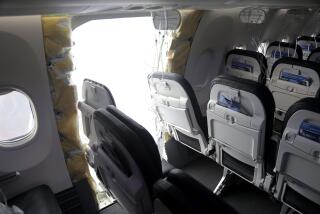Troubled Arctic Challenger cited for small illegal discharges
SEATTLE — The containment vessel designed to capture oil in the event of a spill during exploratory drilling off the coast of Alaska has itself been responsible for four minor illegal fluid discharges during the last three weeks, the Coast Guard confirmed Monday.
The discharges all involved hydraulic fluid and were generally limited to about a quart each time, all of which was contained and cleaned up. The fine was just $250. But the discharges signal Shell Exploration’s continuing problems with the vessel, the Arctic Challenger, whose trouble-plagued retrofit in Bellingham, Wash., has delayed the launch of the first major offshore oil drilling in the U.S. Arctic in 20 years.
“They’re small spills,” Coast Guard spokesman Lt. Cmdr. Jamie Frederick said. “I wouldn’t say that a spill in the yard is necessarily uncommon. But I also wouldn’t say that they happen all the time. It’s common that if you spill something the first time, you get a warning, and at some point the warning turns to a fine, and that’s what you saw here.”
The retrofitting is being undertaken by Superior Energy Marine Technical Services, under contract to Shell.
Though the bulk of Shell’s drilling fleet has long since set sail for Alaska, the Arctic Challenger remains mired in port as workers hurry to try to complete needed fixes before the vessel can be certified by the Coast Guard and the U.S. Bureau of Shipping.
The company’s hoped-for target of finishing the reconstruction by Aug. 15 now has been pushed back to Aug. 30, according to sources familiar with the work. Coast Guard officials said several major systems still remain to be completed before certification can occur.
“At the end of the day, the question is: Is the Arctic Challenger any closer to obtaining a certificate of inspection? The only way to accurately reflect that is through completion of major systems and major subsystems. And as of this moment, I don’t think we’ve made any progress since last Monday,” Coast Guard spokesman Cmdr. C.T. O’Neil told the Los Angeles Times.
As of last week, the Coast Guard said about 400 inspection and plan review items remained to be satisfied, all relating to the design, construction and installation of safety, structural, mooring and machinery systems.
Frederick said all four fluid discharges were self-reported by Superior Energy. They included a spill of a quart of hydraulic fluid due to a ruptured hydraulic line on July 24, for which the company received a warning; another mechanical leak of a quart of hydraulic fluid on Aug. 4, for which another warning was issued; a leak of an additional quart on Aug. 6 due to “equipment failure,” for which the company was fined $250; a discharge of five gallons of fuel on Aug. 7 from a small skiff that is a support vessel to the Arctic Challenger.
Any additional spills would be assessed a civil penalty, Frederick said.
A source familiar with the construction said Shell inspectors were alarmed when they saw evidence of a discharge near the Arctic Challenger.
“When a Shell corporate observer noticed a sheen on the water and inquired with a Superior Energy manager, he was met with resistance and told it was none of his business and to butt out,” said the source, who spoke on condition of anonymity because he was not authorized to discuss the construction. “He insisted it was his business since this project has Shell’s name all over it.… There was quite a commotion on the dock.”
Shell spokesman Curtis Smith said he did not have any information on the accidental releases.
“Having said that, a discharge — no matter how small — is unacceptable. We are pleased with the progress being made and look forward to sea trials in the days ahead,” Smith said in an email to The Times.
With more than $4 billion invested in the long-delayed Arctic drilling program, Shell has had to scale back its ambitions for the summer drilling season and now expects to drill only about two wells in the Beaufort and Chukchi seas.
Interior Secretary Ken Salazar said Monday he had received no concrete proposal from the company to extend the drilling cutoff deadline — put in place to wind up operations and allow time for any needed cleanup before the onset of winter ice. The deadline is currently set for late September in the Chukchi Sea and late October in the Beaufort Sea.
“It’s necessary for Shell to be able to demonstrate that they have met the regulatory requirements that we have put in place,” Salazar said at a news conference in Anchorage. “If they are not met, then there will not be a Shell exploration effort that will take place this year.”
ALSO:
Shark Week 2012: Goodbye Olympics, hello predators
Times Square shooting: Video shows jittery, slo-mo drama
Boater’s strange odyssey exposes gap in JFK airport security
kim.murphy@latimes.com
More to Read
Sign up for Essential California
The most important California stories and recommendations in your inbox every morning.
You may occasionally receive promotional content from the Los Angeles Times.










